Ecl cell - Study guides, Class notes & Summaries
Looking for the best study guides, study notes and summaries about Ecl cell? On this page you'll find 72 study documents about Ecl cell.
Page 3 out of 72 results
Sort by
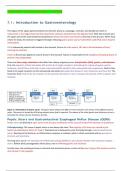
-
RECENT 2023 Module 7 EXAM
- Exam (elaborations) • 13 pages • 2023
-
- $12.89
- + learn more
RECENT 2023 Module 7 EXAM 7.1 : Introduction to Gastroenterology The organs of the upper gastrointestinal tract (mouth, pharynx, esophagus, stomach, and duodenum) work in conjunction to first digest food and then absorb the nutrients obtained from the digested food. Both the stomach and the upper part of the small intestines (duodenum) release hormones and enzymes that help in this process. When food enters the body, the stomach is triggered to begin releasing gastric juices such as hydro...
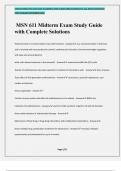
-
MSN 611 Midterm Exam Study Guide with Complete Solutions
- Exam (elaborations) • 21 pages • 2024
-
- $10.49
- + learn more
MSN 611 Midterm Exam Study Guide with Complete Solutions Histamine that is not found within mast cells functions - Answer-as a neurotransmitter in the brain and is involved with neuroendocrine control, cardiovascular functions, thermal and weight regulation, and sleep and arousal balance what cells release histamine in the stomach? - Answer-enterochromaffin-like (ECL) cells Toxicity of antihistamines has been reported in incidents of interactions with: - Answer-liver enzymes Toxic effect ...
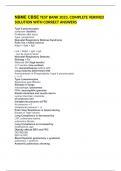
-
NBME CBSE TEST BANK 2023, COMPLETE VERIFIED SOLUTION WITH CORRECT ANSWERS
- Exam (elaborations) • 134 pages • 2023
-
- $12.99
- + learn more
NBME CBSE TEST BANK 2023, COMPLETE VERIFIED SOLUTION WITH CORRECT ANSWERS Type II pneumocytes surfactant (lecithin) Proliferate after injury Type I progenitors Neonatal Respiratory Distress Syndrome Polio live v killed vaccine Killed = Salk = IgG Live = Sabin = IgG + IgA - can be shed in feces Neonatal Respiratory Distress: Etiology + Tx Maternal DM (high insulin) or C-section (low cortisol) TX: dexamethasone before birth Lung maturity determined with Amniocentesis of Phospho...
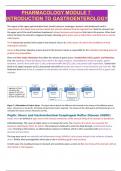
-
PHARMACOLOGY MODULE 7 INTRODUCTION TO GASTROENTEROLOGY
- Exam (elaborations) • 13 pages • 2023
-
- $7.99
- + learn more
The organs of the upper gastrointestinal tract (mouth, pharynx, esophagus, stomach, and duodenum) work in conjunction to first digest food and then absorb the nutrients obtained from the digested food. Both the stomach and the upper part of the small intestines (duodenum) release hormones and enzymes that help in this process. When food enters the body, the stomach is triggered to begin releasing gastric juices such as hydrochloric acid (HCl) and an enzyme called pepsin. HCl is released by ...
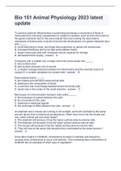
-
Bio 151 Animal Physiology 2023 latest update
- Exam (elaborations) • 31 pages • 2023
- Available in package deal
-
- $37.99
- + learn more
Bio 151 Animal Physiology 2023 latest updateTo achieve optimum effectiveness in promoting exchange or movement of fluids or molecules from one body compartment or system to another, such as from the lumen of the gastro-intestinal tract to the extra-cellular fluid surrounding the baso-lateral membrane of enterocytes, evolution has favored development of a gastro-intestinal tract with _____. A. more branching or folds, and finger-like projections on apical cell membranes B. increased thickness a...
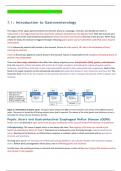
-
RECENT 2023 Module 7 EXAM
- Exam (elaborations) • 13 pages • 2023
-
- $18.49
- + learn more
RECENT 2023 Module 7 EXAM 7.1 : Introduction to Gastroenterology The organs of the upper gastrointestinal tract (mouth, pharynx, esophagus, stomach, and duodenum) work in conjunction to first digest food and then absorb the nutrients obtained from the digested food. Both the stomach and the upper part of the small intestines (duodenum) release hormones and enzymes that help in this process. When food enters the body, the stomach is triggered to begin releasing gastric juices such as hydro...
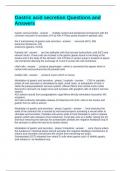
-
Gastric acid secretion Questions and Answers
- Exam (elaborations) • 5 pages • 2024
- Available in package deal
-
- $12.49
- + learn more
Gastric acid secretion Questions and Answers Gastric acid secretion multiple central and peripheral mechanisms with the common end point of secretion of H by H/K ATPase pump located in parietal cells. the 3 mechanisms of gastric acid secretion neuronal (ACh, M3) paracrine (histamine, H2) endocrine (gastrin, CCK2) Previous Play Next Rewind 10 seconds Move forward 10 seconds Unmute 0:00 / 0:15 Full screen Brainpower Read More Parietal cell are the epithelial cells...
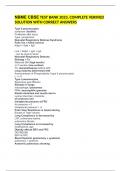
-
NBME CBSE TEST BANK 2023, COMPLETE VERIFIED SOLUTION WITH CORRECT ANSWERS
- Exam (elaborations) • 134 pages • 2024
-
- $27.09
- + learn more
NBME CBSE TEST BANK 2023, COMPLETE VERIFIED SOLUTION WITH CORRECT ANSWERS Type II pneumocytes surfactant (lecithin) Proliferate after injury Type I progenitors Neonatal Respiratory Distress Syndrome Polio live v killed vaccine Killed = Salk = IgG Live = Sabin = IgG + IgA - can be shed in feces Neonatal Respiratory Distress: Etiology + Tx Maternal DM (high insulin) or C-section (low cortisol) TX: dexamethasone before birth Lung maturity determined with Amniocentesis of Phosp...
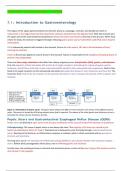
-
RECENT 2023 Module 7 EXAM
- Exam (elaborations) • 13 pages • 2023
-
- $12.39
- + learn more
RECENT 2023 Module 7 EXAM 7.1 : Introduction to Gastroenterology The organs of the upper gastrointestinal tract (mouth, pharynx, esophagus, stomach, and duodenum) work in conjunction to first digest food and then absorb the nutrients obtained from the digested food. Both the stomach and the upper part of the small intestines (duodenum) release hormones and enzymes that help in this process. When food enters the body, the stomach is triggered to begin releasing gastric juices such as hydro...
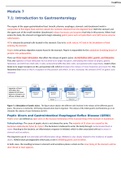
-
PHARMACOLO NURS 251 MODULE 7
- Exam (elaborations) • 13 pages • 2022
- Available in package deal
-
- $9.99
- + learn more
Module 7 7.1: Introduction to Gastroenterology The organs of the upper gastrointestinal tract (mouth, pharynx, esophagus, stomach, and duodenum) work in conjunction to first digest food and then absorb the nutrients obtained from the digested food. Both the stomach and the upper part of the small intestines (duodenum) release hormones and enzymes that help in this process. When food enters the body, the stomach is triggered to begin releasing gastric juices such as hydrochloric acid (HCl) a...

Did you know that on average a seller on Stuvia earns $82 per month selling study resources? Hmm, hint, hint. Discover all about earning on Stuvia


